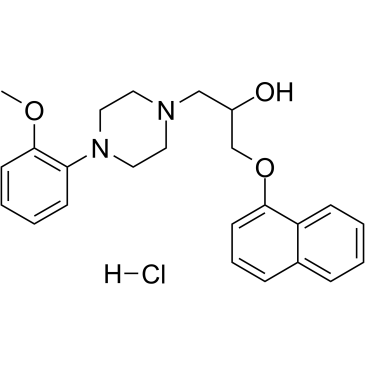1164469-60-6
| Name | Naftopidil hydrochloride |
|---|
| Description | Naftopidil hydrochloride (KT-611 hydrochloride) is a selective alpha1-adrenoceptor antagonist, with antiproliferative effects. Naftopidil dihydrochloride can be used for the research of prostate hyperplasia[1]. |
|---|---|
| Related Catalog | |
| In Vitro | Naftopidil hydrochloride suppresses human prostate tumor growth by altering interactions between tumor cells and stroma[1]. Naftopidil hydrochloride (10 μM for PCa cells; 0.1-10 μM for PrSC) shows growth inhibitory effects on PrSC and PCa cells[1]. Naftopidil hydrochloride (50 μM for E9 cells, 25 μM for PrSC; 48 hours) increased the level of cell-cycle regulatory protein p27 in E9 cells, but not PrSC[1]. Cell Proliferation Assay[1] Cell Line: PCa cells, PrSC Concentration: 10 μM (PCa cells); 0.1 μM, 1 μM, 10 μM (PrSC) Incubation Time: 3 days Result: Exhibited growth inhibitory effects on PCa cells, PrSC in dose-dependent manners. Western Blot Analysis[1] Cell Line: PCa cells, PrSC Concentration: 50 μM (E9 cells), 25 μM (PrSC) Incubation Time: 48 hours Result: Increased the level of cell-cycle regulatory protein p27 in E9 cells, but not PrSC. |
| In Vivo | Naftopidil hydrochloride (10 mg/kg; p.o; daily, for 28 days) decreases microvessel density (MVD) in E9 + PrSC tumors mice model[1]. Animal Model: Male athymic mice(7-8 weeks), with E9 + PrSC xenograft [1] Dosage: 10 mg/kg Administration: Oral administration, daily, for 28 days Result: Decrease tumor weights. |
| References |
| Molecular Formula | C24H29ClN2O3 |
|---|---|
| Molecular Weight | 428.95 |
